Four media leaders from four continents share their thoughts on the future of an industry
There’s little doubt, writes Jon Watkins, that many of the conversations taking place among delegates at this year’s FIPP Congress will centre on how they can stay on top of emerging trends, stay ahead of their competitors and stay on track to thrive in an increasingly competitive market.
So what do four industry leaders from different parts of the world (and who will all speak at the FIPP Congress) think are the solutions to these issues?
Transformation
Of course, one issue that remains a priority for many organisations is the continuing and accelerating evolution into true multiplatform plays – not just in terms of maximising opportunities for communicating with audiences, but also in terms of maximising revenues.
Frederic Kachar, CEO and chairman of Editora Globo in Brazil, says consumers expect a multi-platform approach today.
“Our readers are multiplatform users,” he says. “We want them to engage with their favourite magazines in as many formats as a possible. Basically we need to be where our readers are.
“As a result, all our print subscriptions include digital access to the tablet, mobile and web version of our magazines. For those who prefer digital-only access to our titles, our digital subscription is priced lower than our print + digital combo.
“Our content is created in such a way as to take full advantage of all the possibilities offered by these platforms,” he adds. “We want our readers to have a seamless experience when moving from one platform to another. When Brazilians took to the streets to protest against the government earlier this year, our weekly news magazine Época offered on its website live coverage of the protests with videos and minute-by-minute updates. In the subsequent issue of the magazine, the reader was able to read an in-depth analysis of the coverage that first appeared on the website.”
Aroon Purie, chairman and editor-in-chief of India Today Group – one of the region’s most recognised publishing brands – says the move to multiplatform is certainly accelerating in his region.
“In line with the changing readership habits of our audiences, we have now made most of our print magazines available in digital. Currently, we have 22 digital editions,” he says. “We need to create a single, unified platform that integrates content delivery across all digital channels and devices, culminating in a monetization strategy for content and premium assets.
“The future is multiplatform publishing,” he adds, “and key drivers for revenue will be video advertising and native advertising where non-intrusive ad formats will have prominence. Mobile-first will stay, and we will need to focus on providing content tailored for these devices.
“In short – we need to concentrate on the three Cs: producing engaging ‘content’ that will help us build a ‘community’, which can in turn help us bring in the ‘cash’,” he continues. “To achieve new revenue streams, we need to know our consumers better and offer them content they find useful. For this, we need to capture as much information as possible – explicitly or implicitly. So in-depth understanding of the evolving needs of consumers and effective use of social media are also cornerstones of our digital strategy.”
Joe Ripp was appointed Time Inc chairman and CEO in September 2013 to oversee the spin-off from Time Warner and subsequent transformation – so is well placed to talk about how organisations are handling transformation. He says: “Leading transformation and culture change is about creating a social movement,” he says. “At Time Inc we have smart and talented people throughout our organisation who are accustomed to critical thinking and questioning. My approach has been transparency and candour about both the challenges we face and the sources of opportunity. The key to culture change is achieving grassroots buy-in from the middle.”
Dominant platforms
So which platforms specifically are businesses really excited about going forward? Time Inc’s Ripp says the business is focused on investment in some very clear areas: “We believe we have an advantage when investing in areas that are adjacent to our existing businesses, brands and competencies. This includes experiential or live media (e.g., UKCE, inVNT), digital platforms that service the passion points in our lives (e.g., Horse & Hound/Equo and SI Play), millennial and mobile-first content verticals (e.g., FWx, MIMI), commerce and data,” he says.
Kachar says mobile, video and social media are the strong areas of focus for his business at present, and in Brazil generally.
“Video is a great way to get the attention of our consumers, especially the younger demographic, and increase the relevance of our brands,” he says. “For our fashion magazines, our readers now expect videos with backstage action from a photo shoot or the making of a cover. We also use the medium to offer readers the opportunity to have ‘live’ interaction with our magazine staff. That said, the most important objective we are pursuing is the creation of web series able to drive the mission and personality of our brands, connect and broaden our audience in new ways.
“In terms of mobile, audiences are now consuming news content on mobile more than ever before,” he adds. “We, as publishers, seem to be at the right place at the right time. We have the reputation and the credibility. We are working in making the best possible mobile experience for our audience. It never stops. The design and usability of our mobile sites is constantly evolving. And of course we need to find a way to monetise ourselves through mobile advertising.
“As for social media, that started as great places to get in touch with our audiences in a more personal fashion, but they have become a source of traffic, bringing highly qualified audiences to our sites,” he continues. “They also accelerated the growth of mobile traffic, since people intensively use social networks on their smartphones. We are constantly tweaking our strategies for these channels. For example, we have a strong presence on Instagram for some of our brands, interacting with millions of followers. On Facebook, our strategies to build audience reach and engagement have been referenced internationally.”
Purie says the same trends are emerging in India, too.
“In 2014, India was the world’s fastest-growing smartphone market – with the number of smartphones growing 54 per cent, reaching 140m in number,” he says.
“Social media is also taking more prominence, as more companies make their presence felt on various social media platforms. Facebook is the most preferred for B2C content marketing, LinkedIn for effective B2B content,” he adds.
“In terms of further digital trends, we are seeing that personal content distribution – apps such SnapChat and WhatsApp – is being experimented with by news providers. These apps offer a more personal means of communication than something like a push notification and are ideal for reaching a younger target audience. Also, look out for podcasts continuing their ‘renaissance’ in 2015, particularly in content marketing.”
Quality wins
While the continued growth of digital platforms is creating demand for more content and while new players are entering the market – there is a clear view among leaders that those with a content heritage and an established brand can expect to thrive going forward. Quality, it seems, is king.
“For the first time in this industry, the senior management has no real personal experience of the new business they have to develop – digital. We are not natives. That is a difficult position to be in,” says Pierre Lamunière, head of Swiss family-owned publisher Edipresse.
“Despite that, and even if the challenge is high, I am convinced that the best publishers will survive. But there will be no place for average companies or titles,” he adds. “I believe that consumers will ask for more quality content in the near future and that advertisers will pay more for motivated consumers. To create great content is in the genes of a publisher. So that is an advantage.
“And publishers with deep pockets will buy more and more digital activities from outside the publishing world, to acquire ideas and talents. To succeed, the publishing industry should once again put creativity and entrepreneurship at the centre.”
Embracing these opportunities can also help businesses transform the way they raise revenues, says Kachar.
“I don’t see the future as bleak,” he says. “I see it as challenging. Native advertising, big data and targeted media are some of the tools that can help us out during this testing time. We face an uphill struggle when it comes to monetising digital content of course, and this is getting even steeper with the introduction of schemes like Facebook Instant Articles and Apple News. It’s still too early to say how they’ll affect our business. But we’re dealing with a situation where we no longer have a monopoly on the distribution of our content. It’s up to us to find alternatives.
“We really believe in the revenue potential for native ads, both in print and digital,” he adds. “Last year, we entered a very successful native ad partnership with GE that was renewed and broadened this year, with more features and the addition of a new title added to the lineup.
“The market here also uses programmatic intensively. “We work with the players such as Google, Rubicon and others, using their platforms to get the best results for their campaigns.”
Overall, it seems that, while businesses face many challenges around transformation, talent, strategy and competition, there remains plenty for the industry to be optimistic about, not least the appetite among audiences to consume quality content.
As Time Inc’s Joe Ripp explains: “I won’t speak to the mindset of our peers, but at Time Inc there is a real sense of possibility and a real purpose. Everyday we are igniting, fulfilling and elevating the world’s passions. The audience in this business is a booming one.”
* The FIPP Congress takes place from 13-15 October 2015 (register here).
More like this
What is the impact of cross-border publishing on the industry?









